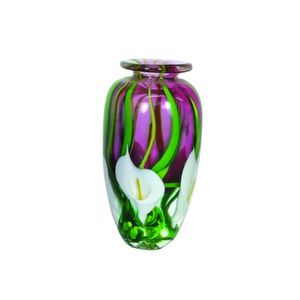Loetz Opaline Glass Vases with Cobalt Stripes
You must be a subscriber, and be logged in to view price and dealer details.
Subscribe Now to view actual auction price for this item
When you subscribe, you have the option of setting the currency in which to display prices to $Au, $US, $NZ or Stg.
- Opalescent / Opaline - The descriptions of glass as "opalescent" or "opaline" are often used interchangeably by dealers and auction houses. At the upper end of the scale, opalescent / opaline glass can refer to the opal-like milky blue glass produced by Lalique and Etling. It also refers to the pressed glass mass produced in Britain from the 1840s with a milky white edge as sugar-basins, milk jugs and vases were made in great quantities for the mass market, and were sold at fairs along with Staffordshire figures and wooden dolls. A less common type of opalescent glass was made from two layers of glass blown into a mould.
- Baluster (glass) - An architectural term for a column in a balustrade or staircase.
When used to describe glass, it can either refer to the shape of the stem of a wine glass, being slender above and pear shaped below, or the shape of the whole vessel, usually a vase. In fact the baluster shape is often described as being vase-like.
The description of a vase as being of baluster shape covers a wide variety of shapes that often bear no resemblance to the original architectural form. - Pontil Mark - A pontil mark, also known as a pontil scar, is a distinctive mark or scar found on the base of certain types of glass. It is a remnant of the glassblowing process and is particularly associated with handcrafted items made prior to the widespread use of automated manufacturing.
The pontil mark is created during the final stages of production. After the glassblower has shaped and formed the glass object, it is removed from the blowing iron. At this point, the glass object is often attached to a solid rod called a pontil rod or punty for further shaping, finishing, or attaching additional components. The attachment point is typically at the base of the object.
Once the glass item is complete, it is detached from the pontil rod, leaving behind a mark or scar on the base. This mark can take various forms, such as a rough or irregular surface, a concave or slightly recessed area, or a small circular scar. The presence of a pontil mark indicates that the item was handcrafted rather than mass-produced.
Collectors and historians often use pontil marks as clues to determine the age, authenticity, and production methods of glass or ceramic pieces. Different types of pontil marks may suggest different techniques used in the production process. For example, an open pontil mark is one where the scar is left as an exposed, roughened area, while a closed pontil mark occurs when the scar is smoothed or covered in some way. It's important to note that not all handcrafted glass items have pontil marks, as some artisans developed alternative methods for finishing their work. In Edwardian times the pontil mark was oftern ground off leaving a concave circle in the centre of the base of the object.
The use of pontil marks diminished with the advent of industrialization and automated manufacturing processes in the 19th and 20th centuries.
This item has been included into following indexes:
Visually similar items

Vintage silver overlay blue glass perfume bottle silver collar to neck, to early blue glass bottle, decorative stopper, height 17 cm

A Peter Raos glass Lily vase, ovoid shape with flaring mouth, decorated with white lilies with green foliage on a cranberry background, signed and dated 1989. Height 14 cm

A Walter Moorcroft lily decorated ovoid vase, red and yellow florals on a variable blue ground with pale toned ground to the shoulder, rolled rim, initials in blue and impressed marks to base. Height 16.3 cm

Large and impressive malachite Art Deco vase with nude decoration
